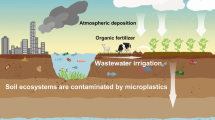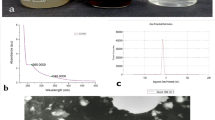Abstract
Genotoxic effects of indium tin oxide (ITO) were investigated on root cells of Allium cepa by employing both Allium and Comet assays. A. cepa roots were treated with the aqueous dispersions of ITO at 5 different concentrations (12.5, 25, 50, 75, and 100 ppm) for 4 h. Exposure of ITO significantly increased mitotic index, and total chromosomal aberrations by the Allium test. While chromosome laggards, stickiness, disturbed anaphase–telophase and anaphase bridges were observed in anaphase–telophase cells, c-metaphase and binuclear cells were observed in other cells. A significant increase in DNA damage was also observed at all concentrations of ITO by the Comet assay. These results indicate that ITO exhibits genotoxic activity in A. cepa root meristematic cells.
Similar content being viewed by others
References
Ajay KL, Sarbhoy R (1988) Cytogenetic studies on the effect of some chlorinated pesticides. Cytologia 53:427–436
Alam MJ, Cameron DC (2002) Investigation of annealing effects on sol–gel deposited indium tin oxide thin films in different atmospheres. Thin Solid Films 420–421:76–82
Amer SM, Ali EM (1986) Cytological effects of pesticides. XVII. Effect of the insecticide dichlorvas on root mitosis of Vicia faba. Cytologia 51:21–25
Asakura K, Satoh H, Chiba M, Okamoto M, Serizawa K, Nakano M, Omae K (2009) Genotoxicity studies of heavy metals: lead bismuth indium silver and antimony. J Occup Health 51:498–512
Badr A, Ghareeb A, El-Din HM (1992) Cytotoxicity of some pesticides in mitotic cells of V. faba roots. Egypt J Appl Sci 7:457–468
Barbério A, Voltolini JC, Mello MLS (2011) Standardization of bulb and root sample sizes for the Allium cepa test. Ecotoxicology 20:927–935
Bustamante J, Dock L, Vahter M, Fowler B, Orrenius S (1997) The semiconductor elements arsenic and indium induce apoptosis in rat thymocytes. Toxicology 118:129–136
Chakraborty R, Mukherjee AK, Mukherjee A (2009) Evaluation of genotoxicity of coal fly ash in Allium cepa root cells by combining comet assay with the Allium test. Environ Monit Assess 153:351–357
Chauhan LKS, Dikshith TSS, Sundararaman V (1986) Effect of deltamethrin on plant cells. Icytological effects on the root meristem cells of Allium cepa. Mutat Res 171:25–30
Chonan T, Taguchi O, Omae K (2007) Interstitial pulmonary disorders in indium-processing workers. Eur Respir J 29:317–324
Collins AR (2004) The comet assay for DNA damage and repair: principles applications and limitations. Mol Biotechnol 26:249–261
Copra KL, Das SR (1983) Thin film solar cell Plenum. New York, p 321
Driscoll KE, Deyo LC, Carter JM, Howard BW, Hassenbein DG, Bertram TA (1997) Effects of particle exposure and particle-elicited inflammatory cells on mutation in rat alveolar epithelial cells. Carcinogenesis 18:423–430
Duez P, Dehon G, Kumps A, Dubois J (2003) Statistics of the comet assay: a key to discriminate between genotoxic effects. Mutagenesis 18:159–166
Elangovan E, Ramamurthi K (2005) Studies on micro-structural and electrical properties of spray-deposited fluorine-doped tin oxide thin films from low-cost precursor. Thin Solid Films 476:231–236
El-Ghamery AA, El-Nahas AI, Mansour MM (2000) The action of atrazine herbicide as an indicator of cell division on chromosomes and nucleic acid content in root meristems of Allium cepa and Vicia faba. Cytologia 65:277–287
Emerit J, Beaumont C, Trivin F (2001) Iron metabolism free radicals and oxidative injury. Biomed Pharmacother 55:333–339
Evseeva TI, Geras’kin SA, Shuktomova II, Taskaev AI (2005) Genotoxicity and cytotoxicity assay of water sampled from the underground nuclear explosion site in the north of the Perm region (Russia). J Environ Radioact 80:59–74
Fan JCC, Goodenough JB (1977) X-ray photoemission spectroscopy studies of Sn-doped indium-oxide films. J Appl Phys 48:3524–3531
Fernandes TCC, Mazzeo DEC, Marin-Morales MA (2007) Mechanism of micronuclei formation in polyploidizated cells of Allium cepa exposed to trifluralin herbicide. Pestic Biochem Phys 88:252–259
Fiskesjö G (1985) The Allium test as standard in environmental monitoring. Hereditas 102:99–112
Fiskesjö G (1988) The Allium test-an alternative in environmental studies: the relative toxicity of metal ions. Mutat Res 197:243–260
Ghosh M, Paul J, Sinha S, Mukherjee A (2010) Comparative evaluation of promutagens o-PDA m-PDA and MH for genotoxic response in root cells of Allium cepa L. Nucleus 53:45–50
Gichner T, Znidar I, Wagner ED, Plewa MJ (2009) The use of higher plants in the Comet assay. In: Dhawan A, Anderson D (eds) The Comet assay in toxicology. Royal Society of Chemistry, UK, pp 98–119
Gottschling BC, Maronpot RR, Hailey JR, Peddada S, Moomaw CR, Klaunig JE, Nyska A (2001) The role of oxidative stress in indium phosphide-induced lung carcinogenesis in rats. Toxicol Sci 64:28–40
Grant WF (1978) Chromosome aberrations in plants as a monitoring system. Environ Health Perspect 27:37–43
Grant WF (1999) Higher plant assays for the detection of chromosomal aberrations and gene mutations—a brief historical background on their use for screening and monitoring environmental chemicals. Mutat Res-Fund Mol Mech 426:107–112
Hamaguchi T, Omae K, Takebayashi T, Kikuchi Y, Yoshioka N, Nishiwaki Y, Tanaka A, Hirata M, Taguchi O, Chonan T (2008) Exposure to hardly soluble indium compounds in ITO production and recycling plants is a new risk for interstitial lung damage. Occup Environ Med 65:51–55
Hasegawa G, Shimonaka M, Ishihara Y (2012) Differential genotoxicity of chemical properties and particle size of rare metal and metal oxide nanoparticles. J Appl Toxicol 32:72–80
Homma T, Ueno T, Sekizawa K, Tanaka A, Hirata M (2003) Interstitial pneumonia developed in a worker dealing with particles containing indium-tin oxide. J Occup Health 45:137–139
Homma S, Miyamoto A, Sakamoto S (2005) Pulmonary fibrosis in an individual occupationally exposed to inhaled indium–tin oxide. Eur Respir J 25:200–204
Hoshina MM (2002) Evaluation of a possible contamination of the waters of the Claro River-Municipality of Rio Claro part of the Corumbataí River Basin with the mutagenicity tests using Allium cepa. State University of São Paulo Rio Claro Sp. (in Portuguese)
Jang HS, Kim DH, Lee HR, Lee SY (2005) Field emission from cone-like single crystalline indium tin oxide nanorods. Mater Lett 59:1526–1529
Konuk M, Liman R, Cigerci IH (2007) Determination of genotoxic effect of boron on Allium cepa root meristematic cells. Pak J Bot 39:73–79
Kovalchuk O, Arkhipov I, Telyuk A, Hohn P, Kovalchuk L (1998) The Allium cepa chromosome aberration test reliably measures genotoxicity of soils of inhabited areas In the Ukraine contaminated by the Chernobyl accident. Mutat Res 415:47–57
Kumari M, Mukherjee A, Chandrasekaran N (2009) Genotoxicity of silver nanoparticles in Allium cepa. Sci Total Environ 407:5243–5246
Kurás M, Nowakowska J, Sliwinska E, Pilarski R, Ilasz R, Tykarska T, Zobel A, Gulewicz K (2006) Changes in chromosome structure mitotic activity and nuclear DNA content from cells of Allium test induced by bark water extract of Uncaria tomentosa (Willd.) DC. J Ethnopharmacol 107:211–221
Kuriyama R, Sakai H (1974) Role of tubulin-Sh groups in polymerization to microtubules. Functional-Sh groups in tubulin for polymerization. J Biochem 76:651–654
Kwee S, Raskmark P, Velizarov S (2001) Changes in cellular proteins due to environmental non-ionizing radiation. I. Heat-shock proteins. Electro-Magnetobiol 20:141–152
Lee H, Kim IG, Cho SW, Lee SH (1997) Effect of process parameters on the characteristics of indium tin oxide thin film for flat panel display application. Thin Solid Films 302:25–30
Leme DM, Marin-Morales MA (2008) Chromosome aberration and micronucleus frequencies in Allium cepa cells exposed to petroleum polluted water—a case study. Mutat Res-Fund Mol Mech 650:80–86
Li D, Haneda H, Hishita S, Ohashi N, Labhsetwar NK (2005) Fluorine-doped TiO2 powders prepared by spray pyrolysis and their improved photocatalytic activity for decomposition of gas-phase acetaldehyde. J Fluorine Chem 126:67–77
Liman R (2013) Genotoxic effects of Bismuth (III) oxide nanoparticles by Allium and Comet assay. Chemosphere 93:269–273
Liman R, Akyıl D, Eren Y, Konuk M (2010) Testing of the mutagenicity and genotoxicity of metolcarb by using both Ames/Salmonella and Allium Test. Chemosphere 80:1056–1061
Liman R, Cigerci IH, Akyıl D, Eren Y, Konuk M (2011) Determination of genotoxicity of fenaminosulf by Allium and Comet tests. Pestic Biochem Phys 99:61–64
Liman R, Gökçe UG, Akyıl D, Eren Y, Konuk M (2012) Evaluation of genotoxic and mutagenic effects of aqueous extract from aerial parts of Linaria genistifolia subsp. genistifolia. Rev Bras Farmacogn 22:541–548
Lin RH, Yang ML, Li YC, Chang HM, Kuan YH (2011) Indium chloride-induced micronuclei via reactive oxygen species in Chinese hamster lung fibroblast V79 cells. Environ Toxicol 28:595–600. doi:10.1002/tox.20755
Lison D, Laloy J, Corazzari I, Muller J, Rabolli V, Panin N, Huaux F, Fenoglio I, Fubini B (2009) Sintered indium-tin-oxide (ITO) particles: a new pneumotoxic entity. Toxicol Sci 108:472–481
Liu HH, Chen CY, Chen GI, Lee LH, Chen HL (2012) Relationship between indium exposure and oxidative damage in workers in indium tin oxide production plants. Int Arch Occup Environ Health 85:447–453
Luo LZ, Werner KM, Gollin SM, Saunders WS (2004) Cigarette smoke induces anaphase bridges and genomic imbalances in normal cells. Mutat Res-Fund Mol Mech 554:375–385
Nagano K, Nishizawa T, Umeda Y, Kasai T, Noguchi T, Gotoh K, Ikawa N, Eitaki Y, Kawasumi Y, Yamauchi T, Arito H, Fukushima S (2011) Inhalation carcinogenicity and chronic toxicity of indium-tin oxide in rats and mice. J Occup Health 53:175–187
Nakajima M, Mitsunaga K, Nakazawa K, Usami M (2008) In vivo/in vitro study in rat embryos on indium-caused tail malformations. Reprod Toxicol 25:426–432
Odeigah PGC, Nurudeen O, Amund OO (1997) Genotoxicity of oil field wastewater in Nigeria. Hereditas 126:161–167
Olive PL, Banath JP (2006) The comet assay: a method to measure DNA damage in individual cells. Nat Protoc 1:23–29
Patel NG, Patel PD, Vaishnav VS (2003) Indium tin oxide (ITO) thin film gas sensor for detection of methanol at room temperature. Sensor Actuat B-Chem 96:180–189
Rank J (2003) The method of allium anaphase–telophase chromosome aberration assay. Ekologija 1:38–42
Rucińska R, Sobkowiak R, Gwóźdź EA (2004) Genotoxicity of lead in lupin root cells as evaluated by the comet assay. Cell Mol Biol Lett 9:519–528
Saxena PN, Chauhan LKS, Gupta SK (2005) Cytogenetic effects of commercial formulation of cypermethrin in root meristem cells of Allium sativum: spectroscopic basis of chromosome damage. Toxicology 216:244–252
Seth CS, Misra V, Chauhan LKS, Singh RR (2008) Genotoxicity of cadmium on root meristem cells of Allium cepa: cytogenetic and Comet assay approach. Ecotoxicol Environ Safe 71:711–716
Shahin SA, El-Amoodi KHH (1991) Induction of numerical chromosomal aberrations during DNA synthesis using fungicides nimrod and rubigan-4 in root tips of Vicia faba L. Mutat Res-Genet Toxicol 261:169–176
Singh NP, McCoy MT, Tice RR, Schneider EL (1998) A simple technique for quantitation of low levels of DNA damage in individual cells. Exp Cell Res 175:184–191
Takagi R, Suzuki Y, Seki Y, Ikehata M, Kajihara C, Shimizu H, Yanagisawa H (2011) Indium chloride-induced micronuclei in in vivo and in vitro experimental systems. J Occup Health 53:102–109
Tanaka A, Hirata M, Homma T, Kiyohara Y (2010) Chronic pulmonary toxicity study of indium–tin oxide and indium oxide following intratracheal instillations into the lungs of hamsters. J Occup Health 52:14–22
Tice RR, Agurell E, Anderson D, Burlinson B, Hartmann A, Kobayashi H, Miyamae Y, Rojas YF, Ryu E, Sasaki JC (2000) Single cell gel/comet assay: guidelines for in vitro and in vivo genetic toxicology testing. Environ Mol Mutagen 35:206–221
Tkalec M, Malaric K, Pavlica M, Pevalek-Kozlina B, Vidakovic-Cifrek Z (2009) Effects of radiofrequency electromagnetic fields on seed germination and root meristematic cells of Allium cepa L. Mutat Res-Fund Mol Mech 672:76–81
Türkoğlu Ş (2012) Determination of genotoxic effects of chlorfenvinphos and fenbuconazole in Allium cepa root cells by mitotic activity chromosome aberration DNA content and comet assay. Pestic Biochem Phys 103:224–230
Author information
Authors and Affiliations
Corresponding author
Rights and permissions
About this article
Cite this article
Ciğerci, İ.H., Liman, R., Özgül, E. et al. Genotoxicity of indium tin oxide by Allium and Comet tests. Cytotechnology 67, 157–163 (2015). https://doi.org/10.1007/s10616-013-9673-0
Received:
Accepted:
Published:
Issue Date:
DOI: https://doi.org/10.1007/s10616-013-9673-0




